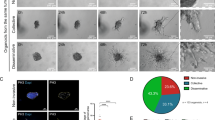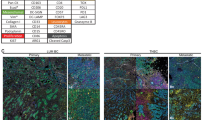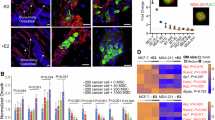Abstract
Background
Breast cancer distant metastasis is known to exhibit organotropism, with triple negative breast cancer (TNBC) subtypes also displaying organ-specific metastasis. The precise regulatory mechanisms governing this specificity remain unclear.
Methods
Retrospective analysis of metastatic data from public databases was utilized to explore the organotropism of TNBC subtypes. Mouse models combined with single-cell sequencing and immunoprecipitation (CoIP) experiments were utilized to investigate the role and mechanism of androgen receptor (AR) on TNBC bone metastasis. Further analysis of the bone microenvironment combined with CUT&TAG sequencing and osteoclast differentiation experiments was performed to validate the effect of AR and c-Myc interaction on macrophage-osteoclast axis differentiation.
Results
Analysis revealed the luminal androgen receptor (LAR) TNBC subtype had significant bone metastasis propensity. Mouse models showed AR activation promoted LAR TNBC bone metastasis. Using single-cell sequencing, we discovered that c-Myc played a critical role in AR-mediated bone metastasis. Further investigation of the bone microenvironment showed that AR-c-Myc interaction promoted macrophage-osteoclast axis differentiation and macrophage activation via MMP13, ultimately increasing bone resorption.
Conclusions
AR and c-Myc interaction induces macrophage differentiation into osteoclasts and promotes TNBC bone metastasis. These findings elucidate the mechanisms underlying bone metastasis in TNBC subtypes and inform potential interventions for TNBC bone metastasis.
This is a preview of subscription content, access via your institution
Access options
Subscribe to this journal
Receive 24 print issues and online access
$259.00 per year
only $10.79 per issue
Buy this article
- Purchase on SpringerLink
- Instant access to full article PDF
Prices may be subject to local taxes which are calculated during checkout







Similar content being viewed by others
Data availability
The accession number for the scRNA-seq data of Ctrl and DHT bone metastatic tumors and CUT&TAG-seq data generated in this article is GEO(GSE236558) and SRA(PRJNA1268216). Other data analyzed in this study were obtained from GEO with accession numbers GSE2603, GSE2034, GSE12276, GSE125989, and GSE110590. All other raw data are available upon request from the corresponding author. Full, uncut gel images are available in the supplemental materials.
References
Si-Qing L, Zhi-Jie G, Juan W, Hong-Mei Z, Bei L, Si S, et al. Single-cell and spatially resolved analysis uncovers cell heterogeneity of breast cancer. J Hematol Oncol. 2022;15:19.
Liang Y, Zhang H, Song X, Yang Q. Metastatic heterogeneity of breast cancer: molecular mechanism and potential therapeutic targets. Semin cancer Biol. 2020;60:14–27.
Fan JH, Zhang S, Yang H, Yi ZB, Ouyang QC, Yan M, et al. Molecular subtypes predict the preferential site of distant metastasis in advanced breast cancer: a nationwide retrospective study. Front Oncol. 2023;13:978985.
Soni A, Ren Z, Hameed O, Chanda D, Morgan CJ, Siegal GP, et al. Breast cancer subtypes predispose the site of distant metastases. Am J Clin Pathol. 2015;143:471–8.
Foulkes WD, Smith IE, Reis-Filho JS. Triple-negative breast cancer. N Engl J Med. 2010;363:1938–48.
Morante Z, Ku GADlC, Enriquez D, Saavedra A, Luján M, Luque R, et al. Post-recurrence survival in triple negative breast cancer. J Clin Oncol. 2018;36:e13120-e.
Lehmann BD, Bauer JA, Chen X, Sanders ME, Chakravarthy AB, Shyr Y, et al. Identification of human triple-negative breast cancer subtypes and preclinical models for selection of targeted therapies. J Clin Investig. 2011;121:2750–67.
Dent R, Trudeau M, Pritchard KI, Hanna WM, Kahn HK, Sawka CA, et al. Triple-negative breast cancer: clinical features and patterns of recurrence. Clin Cancer Res. 2007;13:4429–34.
Salvi S, Bonafè M, Bravaccini S. Androgen receptor in breast cancer: a wolf in sheep’s clothing? A lesson from prostate cancer. Semin cancer Biol. 2020;60:132–7.
Tan M, Li J, Xu H, Melcher K, Yong E. Androgen receptor: structure, role in prostate cancer and drug discovery. Acta Pharmacol Sin. 2015;36:3–23.
Karantanos T, Corn P, Thompson T. Prostate cancer progression after androgen deprivation therapy: mechanisms of castrate resistance and novel therapeutic approaches. Oncogene. 2013;32:5501–11.
Sharifi N, McPhaul M, Auchus R. Getting from here to there”-mechanisms and limitations to the activation of the androgen receptor in castration-resistant prostate cancer. J Investig Med. 2010;58:938–44.
Bock N, Shokoohmand A, Kryza T, Röhl J, Meijer J, Tran P, et al. Engineering osteoblastic metastases to delineate the adaptive response of androgen-deprived prostate cancer in the bone metastatic microenvironment. Bone Res. 2019;7:13.
Yin J, Liu Y, Tillman H, Barrett B, Hewitt S, Ylaya K, et al. AR-regulated TWEAK-FN14 pathway promotes prostate cancer bone metastasis. Cancer Res. 2014;74:4306–17.
El-Kenawi A, Dominguez-Viqueira W, Liu M, Awasthi S, Abraham-Miranda J, Keske A, et al. Macrophage-derived cholesterol contributes to therapeutic resistance in prostate cancer. Cancer Res. 2021;81:5477–90.
Li X, Selli C, Zhou H, Cao J, Wu S, Ma R, et al. Macrophages promote anti-androgen resistance in prostate cancer bone disease. J Exp Med. 2023;220:e20221007.
Hickey T, Selth L, Chia K, Laven-Law G, Milioli H, Roden D, et al. The androgen receptor is a tumor suppressor in estrogen receptor-positive breast cancer. Nat Med. 2021;27:310–20.
Park S, Koo J, Kim M, Park H, Lee J, Lee J, et al. Androgen receptor expression is significantly associated with better outcomes in estrogen receptor-positive breast cancers. Ann Oncol. 2011;22:1755–62.
Aceto N, Bardia A, Wittner B, Donaldson M, O’Keefe R, Engstrom A, et al. AR expression in breast cancer CTCs associates with bone metastases. Mol Cancer Res. 2018;16:720–7.
Gerratana L, Basile D, Buono G, De Placido S, Giuliano M, Minichillo S, et al. Androgen receptor in triple negative breast cancer: a potential target for the targetless subtype. Cancer Treat Rev. 2018;68:102–10.
Coleman R, Croucher P, Padhani A, Clézardin P, Chow E, Fallon M, et al. Bone metastases. Nat Rev Dis Prim. 2020;6:83.
Zhang L, Wang Y, Gu Y, Hou Y, Chen Z. The need for bone biopsies in the diagnosis of new bone lesions in patients with a known primary malignancy: a comparative review of 117 biopsy cases. J Bone Oncol. 2019;14:100213.
Zhang W, Bado I, Hu J, Wan Y, Wu L, Wang H, et al. The bone microenvironment invigorates metastatic seeds for further dissemination. Cell. 2021;184:2471–86.e20.
Chevalier C, Çolakoğlu M, Brun J, Thouverey C, Bonnet N, Ferrari S, et al. Primary mouse osteoblast and osteoclast culturing and analysis. STAR Protoc. 2021;2:100452.
Wolf F, Angerer P, Theis F. SCANPY: large-scale single-cell gene expression data analysis. Genome Biol. 2018;19:15.
Gulati G, Sikandar S, Wesche D, Manjunath A, Bharadwaj A, Berger M, et al. Single-cell transcriptional diversity is a hallmark of developmental potential. Science. 2020;367:405–11.
Qiu X, Hill A, Packer J, Lin D, Ma Y, Trapnell C. Single-cell mRNA quantification and differential analysis with Census. Nat Methods. 2017;14:309–15.
Van de Sande B, Flerin C, Davie K, De Waegeneer M, Hulselmans G, Aibar S, et al. A scalable SCENIC workflow for single-cell gene regulatory network analysis. Nat Protoc. 2020;15:2247–76.
Stewart C, Gay C, Xi Y, Sivajothi S, Sivakamasundari V, Fujimoto J, et al. Single-cell analyses reveal increased intratumoral heterogeneity after the onset of therapy resistance in small-cell lung cancer. Nat Cancer. 2020;1:423–36.
Andreatta M, Carmona S. UCell: robust and scalable single-cell gene signature scoring. Comput Struct Biotechnol J. 2021;19:3796–8.
Chen X, Li J, Gray W, Lehmann B, Bauer J, Shyr Y, et al. TNBCtype: a subtyping tool for triple-negative breast cancer. Cancer Inf. 2012;11:147–56.
Yu C, Wang H, Muscarella A, Goldstein A, Zeng H, Bae Y, et al. Intra-iliac artery injection for efficient and selective modeling of microscopic bone metastasis. J Vis Exp. 2016;115:53982.
Barton VN, D’Amato NC, Gordon MA, Lind HT, Spoelstra NS, Babbs BL, et al. Multiple molecular subtypes of triple-negative breast cancer critically rely on androgen receptor and respond to enzalutamide. Mol Cancer Therapeutics. 2015;14:769–78.
Yin J, Pollock C, Kelly K. Mechanisms of cancer metastasis to the bone. Cell Res. 2005;15:57–62.
Cao L, Xu C, Xiang G, Liu F, Liu X, Li C, et al. AR-PDEF pathway promotes tumour proliferation and upregulates MYC-mediated gene transcription by promoting MAD1 degradation in ER-negative breast cancer. Mol Cancer. 2018;17:136.
Zheng Y, Zhou H, Dunstan C, Sutherland R, Seibel M. The role of the bone microenvironment in skeletal metastasis. J Bone Oncol. 2013;2:47–57.
Bied M, Ho WW, Ginhoux F, Blériot C. Roles of macrophages in tumor development: a spatiotemporal perspective. Cell Mol Immunol. 2023;20:983–92.
Lau Y, Danks L, Sun S, Fox S, Sabokbar A, Harris A, et al. RANKL-dependent and RANKL-independent mechanisms of macrophage-osteoclast differentiation in breast cancer. Breast Cancer Res Treat. 2007;105:7–16.
Xiao Y, Palomero J, Grabowska J, Wang L, de Rink I, van Helvert L, et al. Macrophages and osteoclasts stem from a bipotent progenitor downstream of a macrophage/osteoclast/dendritic cell progenitor. Blood Adv. 2017;1:1993–2006.
Kong L, Smith W, Hao D. Overview of RAW264.7 for osteoclastogensis study: phenotype and stimuli. J Cell Mol Med. 2019;23:3077–87.
Mundy G. Metastasis to bone: causes, consequences and therapeutic opportunities. Nat Rev Cancer. 2002;2:584–93.
Garrido-Castro A, Lin N, Polyak K. Insights into molecular classifications of triple-negative breast cancer: improving patient selection for treatment. Cancer Discov. 2019;9:176–98.
Bock N, Kryza T, Shokoohmand A, Röhl J, Ravichandran A, Wille M, et al. In vitro engineering of a bone metastases model allows for study of the effects of antiandrogen therapies in advanced prostate cancer. Sci Adv. 2021;7:eabg2564.
Bai S, Cao S, Jin L, Kobelski M, Schouest B, Wang X, et al. A positive role of c-Myc in regulating androgen receptor and its splice variants in prostate cancer. Oncogene. 2019;38:4977–89.
Qiu X, Boufaied N, Hallal T, Feit A, de Polo A, Luoma A, et al. MYC drives aggressive prostate cancer by disrupting transcriptional pause release at androgen receptor targets. Nat Commun. 2022;13:2559.
Elsers D, Masoud E, Kamel N, Ahmed A. Immunohistochemical signaling pathways of triple negative and triple positive breast cancers: what is new?. Ann Diagnostic Pathol. 2021;55:151831.
Ni M, Chen Y, Fei T, Li D, Lim E, Liu X, et al. Amplitude modulation of androgen signaling by c-MYC. Genes Dev. 2013;27:734–48.
Sun Y, Li J, Xie X, Gu F, Sui Z, Zhang K, et al. Macrophage-osteoclast associations: origin, polarization, and subgroups. Front Immunol. 2021;12:778078.
Escamilla J, Schokrpur S, Liu C, Priceman S, Moughon D, Jiang Z, et al. CSF1 receptor targeting in prostate cancer reverses macrophage-mediated resistance to androgen blockade therapy. Cancer Res. 2015;75:950–62.
Yamaguchi T, Movila A, Kataoka S, Wisitrasameewong W, Ruiz Torruella M, Murakoshi M, et al. Proinflammatory M1 macrophages inhibit RANKL-induced osteoclastogenesis. Infect Immun. 2016;84:2802–12.
Sun H, Wang H, Gao C, Tai L, Yang Y, Dong H, et al. F4/80+CD206+ M2-like macrophages contribute to bone erosion in collagen-induced arthritis by differentiating into osteoclasts. Eur J Inflamm. 2023;21:1721727X231194595.
Acknowledgements
This work was supported by a Key National Natural Science Foundation of China (No.82430093).
Author information
Authors and Affiliations
Contributions
Y. Liu: Conceptualization, data curation, software, formal analysis, investigation, visualization, methodology, writing–original draft. L. Fan: Data curation, software, formal analysis, investigation, visualization, methodology. F. Ye: Investigation, visualization, methodology. Y. Zhao: Investigation, visualization, methodology. Y. Zhu: Data curation, software, formal analysis, investigation. Y. Yang: Data curation, software, formal analysis, supervision. F. Xu: Data curation, supervision. Y. Gu: Data curation, supervision. X. Guan: Conceptualization, resources, data curation, supervision, project administration, writing–review and editing. Y. Liu, L. Fan and F. Ye contributed equally to this work as first authors. All authors read and approved the final paper.
Corresponding author
Ethics declarations
Competing interests
The authors declare no competing interests.
Ethics approval and consent to participate
All animal studies were conducted according to the NIH Guide for the Care and Use of Laboratory Animals (National Academies Press, 2011) and were approved by the Institutional Animal Care and Use Committee of Nanjing Medical University (IACUC-2205019).
Additional information
Publisher’s note Springer Nature remains neutral with regard to jurisdictional claims in published maps and institutional affiliations.
Supplementary information
Rights and permissions
Springer Nature or its licensor (e.g. a society or other partner) holds exclusive rights to this article under a publishing agreement with the author(s) or other rightsholder(s); author self-archiving of the accepted manuscript version of this article is solely governed by the terms of such publishing agreement and applicable law.
About this article
Cite this article
Liu, Y., Fan, L., Ye, F. et al. Androgen receptor interacts with c-Myc to regulate macrophage-osteoclast axis and drive bone metastasis in triple negative breast cancer. Br J Cancer (2025). https://doi.org/10.1038/s41416-025-03202-2
Received:
Revised:
Accepted:
Published:
DOI: https://doi.org/10.1038/s41416-025-03202-2



